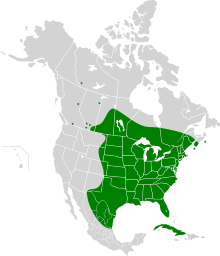Eastern red bat
The eastern red bat (Lasiurus borealis) is a type of microbat in the family Vespertilionidae. Eastern red bats are found across eastern North America. It has also been seen in Bermuda.
| Eastern red bat | |
|---|---|

| |
| Scientific classification | |
| Domain: | Eukaryota |
| Kingdom: | Animalia |
| Phylum: | Chordata |
| Class: | Mammalia |
| Order: | Chiroptera |
| Family: | Vespertilionidae |
| Genus: | Lasiurus |
| Species: | L. borealis
|
| Binomial name | |
| Lasiurus borealis Müller, 1776
| |

| |
| Synonyms | |
| |
Description
changeThe color of the fur of males is brick or rusty red. The color of the fur of females is a bit more frosted shade of red.[2] It weighs 7–13 g (0.25–0.46 oz). It is 109 mm (4.3 in) long. Its ears are short and rounded. Its wings are long and pointed. Its tail is 52.7 mm (2.07 in) long.[3]
Distribution
changeThe eastern red bat is found throughout eastern North America and Bermuda.[4] It is found east of the Continental Divide, including southern Canada and northeastern Mexico. In the winter, it is found in the southeastern United States and northeastern Mexico, and mainly lives in coastal areas. In the spring and summer, it can be found in the Great Lakes region and the Great Plains region.[5]
Feeding
changeEastern red bats are insectivorous. They mainly eat moths. But, they also eat other insects. They eat many pests, like spongy moths, tent caterpillar moths, Cydia moths, Acrobasis moths, cutworm moths, and coneworm moths.[6]
Reproduction
changeEastern red bat breeding season starts in the autumn.[7] Many males can mate with one female.[8] Pups are born in the summer.[7] Eastern red bats usually give birth to three pups.[9] Eastern red bat pups learn to fly when they are a month old. After learning how to fly they are weaned.[7] Even after the pups have learned how to fly, they stay with their mother for a short time before staying by themselves.[8]
References
change- ↑ Arroyo-Cabrales, J.; Miller, B.; Reid, F.; Cuarón, A.D.; de Grammont, P.C. (2016). "Lasiurus borealis". IUCN Red List of Threatened Species. 2016: e.T11347A22121017. doi:10.2305/IUCN.UK.2016-1.RLTS.T11347A22121017.en.
- ↑ Whitaker, John O. (1998). Mammals of the Eastern United States. Hamilton, William J. (William John), Jr., 1902-1990. (3rd ed.). Ithaca: Comstock Pub. Associates. ISBN 0-8014-3475-0. OCLC 38438640.
- ↑ Shump, Karl A.; Shump, Ann U. (1982-06-18). "Lasiurus borealis". Mammalian Species (183): 1–6. doi:10.2307/3503843. JSTOR 3503843. S2CID 253901188.
- ↑ Mammal species of the world : a taxonomic and geographic reference. Wilson, Don E., Reeder, DeeAnn M. (3rd ed.). Baltimore: Johns Hopkins University Press. 2005. ISBN 0-8018-8221-4. OCLC 57557352.
{{cite book}}: CS1 maint: others (link) - ↑ Cryan, Paul M. (2003). <0579:sdomtb>2.0.co;2 "Seasonal Distribution of Migratory Tree Bats (Lasiurus and Lasionycteris) in North America". Journal of Mammalogy. 84 (2): 579–593. doi:10.1644/1545-1542(2003)084<0579:sdomtb>2.0.co;2. ISSN 0022-2372. S2CID 86335242.
- ↑ Clare, Elizabeth L.; Fraser, Erin E.; Braid, Heather E.; Fenton, M. Brock; Hebert, Paul D. N. (2009). "Species on the menu of a generalist predator, the eastern red bat ( Lasiurus borealis ): using a molecular approach to detect arthropod prey". Molecular Ecology. 18 (11): 2532–2542. doi:10.1111/j.1365-294X.2009.04184.x. PMID 19457192. S2CID 3940026.[permanent dead link]
- ↑ 7.0 7.1 7.2 "Eastern Red Bat (Lasiurus borealis)". tpwd.texas.gov. Retrieved 2020-10-26.
- ↑ 8.0 8.1 Schmidly, David J., 1943- (9 August 2016). The mammals of Texas. Bradley, Robert Dean, 1960- (Seventh edition (second University of Texas Press edition) ed.). Austin. ISBN 978-1-4773-0886-8. OCLC 919068314.
{{cite book}}: CS1 maint: location missing publisher (link) CS1 maint: multiple names: authors list (link) CS1 maint: numeric names: authors list (link) - ↑ Kurta, Allen, 1952- (12 May 2017). Mammals of the Great Lakes region (Third ed.). Ann Arbor. ISBN 978-0-472-07345-0. OCLC 966436392.
{{cite book}}: CS1 maint: location missing publisher (link) CS1 maint: multiple names: authors list (link) CS1 maint: numeric names: authors list (link)
